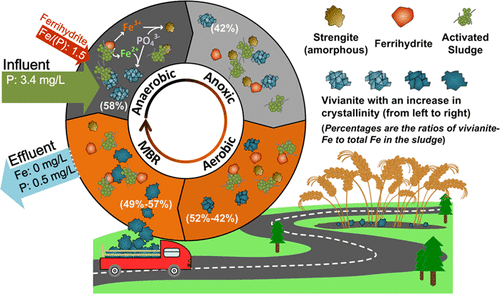当前位置:
X-MOL 学术
›
Environ. Sci. Technol.
›
论文详情
Our official English website, www.x-mol.net, welcomes your
feedback! (Note: you will need to create a separate account there.)
Iron Transformation and Its Role in Phosphorus Immobilization in a UCT-MBR with Vivianite Formation Enhancement.
Environmental Science & Technology ( IF 10.8 ) Pub Date : 2020-09-08 , DOI: 10.1021/acs.est.0c01205 Shaoyu Deng 1 , Changyong Zhang 2 , Yan Dang 1 , Richard N Collins 2 , Andrew S Kinsela 2 , Jingbao Tian 1 , Dawn E Holmes 3 , Hongsuo Li 1 , Bin Qiu 1 , Xiang Cheng 1, 2 , T David Waite 2
Environmental Science & Technology ( IF 10.8 ) Pub Date : 2020-09-08 , DOI: 10.1021/acs.est.0c01205 Shaoyu Deng 1 , Changyong Zhang 2 , Yan Dang 1 , Richard N Collins 2 , Andrew S Kinsela 2 , Jingbao Tian 1 , Dawn E Holmes 3 , Hongsuo Li 1 , Bin Qiu 1 , Xiang Cheng 1, 2 , T David Waite 2
Affiliation

|
The formation of vivianite (Fe3(PO4)2·8H2O) in iron (Fe)-dosed wastewater treatment facilities has the potential to develop into an economically feasible method of phosphorus (P) recovery. In this work, a long-term steady FeIII-dosed University of Cape Town process-membrane bioreactor (UCT-MBR) system was investigated to evaluate the role of Fe transformations in immobilizing P via vivianite crystallization. The highest fraction of FeII, to total Fe (Fetot), was observed in the anaerobic chamber, revealing that a redox condition suitable for FeIII reduction was established by improving operational and configurational conditions. The supersaturation index for vivianite in the anaerobic chamber varied but averaged ∼4, which is within the metastable zone and appropriate for its crystallization. Vivianite accounted for over 50% of the Fetot in the anaerobic chamber, and its oxidation as it passed through the aerobic chambers was slow, even in the presence of high dissolved oxygen concentrations at circumneutral pH. This study has shown that the high stability and growth of vivianite crystals in oxygenated activated sludge can allow for the subsequent separation of vivianite as a P recovery product.
中文翻译:

在具有Vivianite形成增强作用的UCT-MBR中,铁的转化及其在磷固定化中的作用。
在掺铁(Fe)的废水处理设施中形成堇青石(Fe 3(PO 4)2 ·8H 2 O)具有发展成为经济上可行的磷(P)回收方法的潜力。在这项工作中,研究了长期稳定的由Fe III掺杂的开普敦大学过程膜生物反应器(UCT-MBR)系统,以评估Fe转变在通过堇青石结晶固定P方面的作用。在厌氧室中观察到Fe II占总Fe(Fe tot)的比例最高,表明适用于Fe III的氧化还原条件减少是通过改善操作和配置条件来实现的。厌氧室内的Vivianite的过饱和指数变化,但平均为〜4,在亚稳区内且适合其结晶。蓝铁矿占铁的50%以上TOT在厌氧室中,并且其氧化因为它通过需氧腔室传递速度慢,即使在高的溶解氧浓度在pH值circumneutral存在。这项研究表明,氧化的活性污泥中的Vivianite晶体具有很高的稳定性和生长能力,可以随后分离出作为P回收产物的Vivianite。
更新日期:2020-10-06
中文翻译:

在具有Vivianite形成增强作用的UCT-MBR中,铁的转化及其在磷固定化中的作用。
在掺铁(Fe)的废水处理设施中形成堇青石(Fe 3(PO 4)2 ·8H 2 O)具有发展成为经济上可行的磷(P)回收方法的潜力。在这项工作中,研究了长期稳定的由Fe III掺杂的开普敦大学过程膜生物反应器(UCT-MBR)系统,以评估Fe转变在通过堇青石结晶固定P方面的作用。在厌氧室中观察到Fe II占总Fe(Fe tot)的比例最高,表明适用于Fe III的氧化还原条件减少是通过改善操作和配置条件来实现的。厌氧室内的Vivianite的过饱和指数变化,但平均为〜4,在亚稳区内且适合其结晶。蓝铁矿占铁的50%以上TOT在厌氧室中,并且其氧化因为它通过需氧腔室传递速度慢,即使在高的溶解氧浓度在pH值circumneutral存在。这项研究表明,氧化的活性污泥中的Vivianite晶体具有很高的稳定性和生长能力,可以随后分离出作为P回收产物的Vivianite。











































 京公网安备 11010802027423号
京公网安备 11010802027423号